Submental fullness, commonly known as a double chin, is a concern for many individuals. According to the American Society for Dermatologic Surgery, up to 68% of people are affected by this condition.
The quest for ridding a double chin has led to various approaches, ranging from non-invasive exercises and lifestyle changes to surgical interventions. Understanding the underlying causes is crucial before selecting a treatment.
Different methods work for different types of double chin, and realistic expectations regarding results and timeframes vary. This comprehensive guide will cover causes, exercises, lifestyle changes, non-surgical treatments, surgical options, recovery expectations, and decision-making factors.
Key Takeaways
- Understanding the causes of a double chin is essential for choosing the right treatment.
- Various treatments are available, from non-invasive to surgical options.
- Different methods are suited for different types of double chin.
- Realistic expectations regarding results and timeframes are crucial.
- A comprehensive approach includes lifestyle changes and exercises.
Understanding Double Chin: Causes and Prevalence
Understanding the causes and prevalence of double chin is crucial for determining the best course of treatment. A double chin, medically referred to as submental fullness, can result from a combination of factors.
What Causes Submental Fullness
Submental fullness is often caused byexcess fatbeneath the chin, which can be attributed to genetics, weight gain, or aging. As people age, the skin loses its elasticity, and fat can accumulate beneath the chin.
How Common Double Chins Are
According to the American Society for Dermatologic Surgery, as many as68 percentof people have a double chin. This condition is not limited to any specific age group or demographic.
Determining Your Double Chin Type
There are different types of double chins, including fat-dominant, skin-dominant, and muscle-related. To determine your double chin type, consider the following factors:
- The amount of loose skin under your chin
- The presence of excess fat beneath the chin
- The definition of your jawline and facial structure
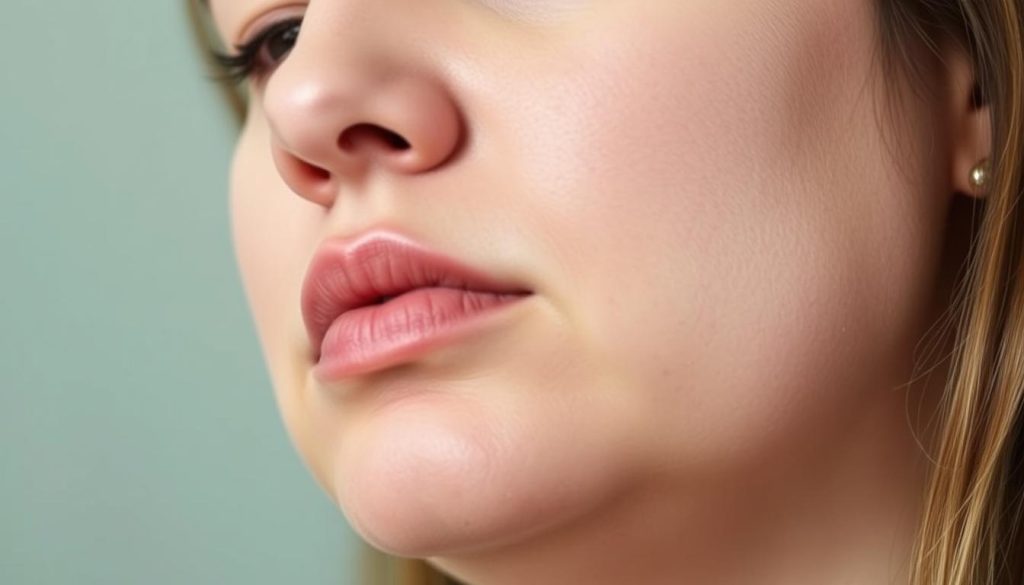
Proper diagnosis is essential for effective treatment. By understanding the underlying cause of your double chin, you can choose the most suitable treatment approach.
Effective Facial Exercises for Double Chin Reduction
Strengthening the muscles under the chin through facial exercises may help reduce the appearance of a double chin. While there’s no scientific evidence that these exercises work, anecdotal evidence suggests they can be beneficial.
Straight Jaw Jut and Bottom Jaw Jut
The Straight Jaw Jut involves tilting the head back and pushing the lower jaw forward, holding for 10 counts. This exercise targets the muscles under the chin. The Bottom Jaw Jut is similar, but involves turning the head to the side while sliding the bottom jaw forward.
Ball Exercise and Neck Stretch
The Ball Exercise requires placing a 9-10 inch ball under the chin and pressing down. The Neck Stretch involves tilting the head back and pressing the tongue against the roof of the mouth, targeting the platysma muscle.
Tongue Stretch and Pucker Up
The Tongue Stretch involves sticking the tongue out and lifting it toward the nose, holding for 10 seconds. The Pucker Up exercise involves tilting the head back and puckering the lips, strengthening facial muscles.
Creating an Exercise Routine
To see results, it’s essential to create a consistent exercise routine. Start with a few repetitions and gradually increase the frequency and duration. A sample routine could be:
| Exercise | Repetitions | Frequency |
|---|---|---|
| Straight Jaw Jut | 10 | 3 times a day |
| Ball Exercise | 5 | 2 times a day |
| Tongue Stretch | 10 | 3 times a day |
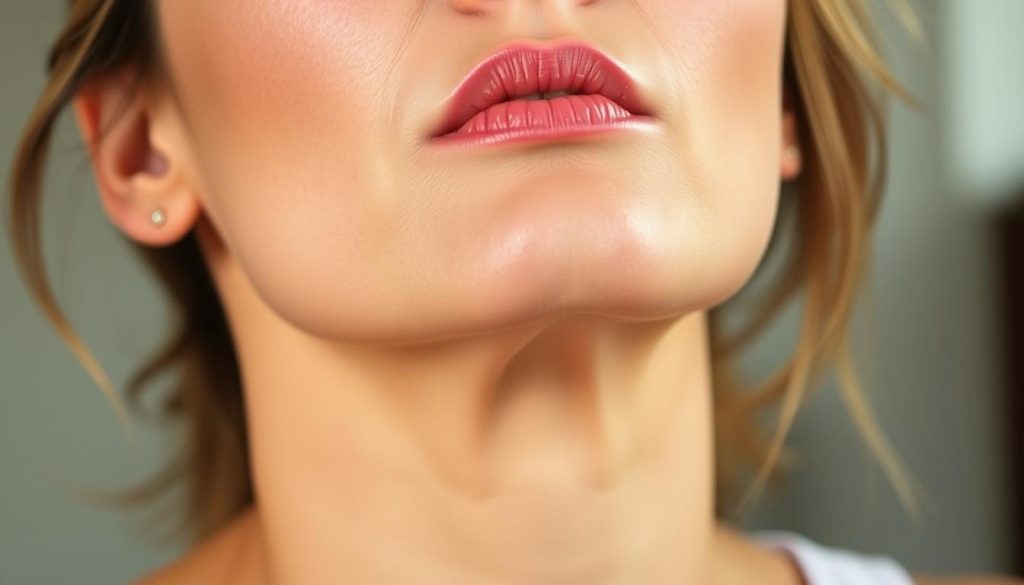
By incorporating these exercises into your daily routine, you may be able to rid double chin and achieve a more defined chin and neck area.
Lifestyle Changes to Reduce Double Chin
For many, a double chin is a result of weight gain, and addressing this issue requires a multifaceted approach. Losing weight, if the double chin is related to being overweight, can significantly reduce its appearance.
Weight Loss Strategies
To lose weight and potentially rid double chin, it’s essential to adopt a healthy diet and regular exercise routine. Eating more fruits and vegetables, replacing refined grains with whole grains, and avoiding processed foods are key dietary adjustments.
Dietary Recommendations
A healthy diet rich in lean protein, healthy fats, and low-fat dairy products can support weight loss. It’s also crucial to stay within daily calorie needs. Certain foods can cause facial bloating and should be avoided.
Physical Activity Guidelines
Regular physical activity, including cardiovascular exercises and targeted movements for the neck and chin area, can help reduce overall body fat. This, in turn, can help minimize the appearance of a double chin.
Maintaining Results Long-Term
To maintain weight loss and the reduction of double chin, it’s vital to adopt sustainable lifestyle habits. Proper hydration also plays a significant role in reducing facial puffiness and supporting overall health.
| Lifestyle Change | Benefit |
|---|---|
| Eating a balanced diet | Supports weight loss and overall health |
| Regular exercise | Reduces body fat, including around the chin area |
| Proper hydration | Reduces facial puffiness |
By implementing these lifestyle changes, individuals can not only reduce their double chin but also improve their overall health and well-being. It’s about adopting a healthier lifestyle that promotes long-term results.
Non-Surgical Double Chin Reduction Methods
Advances in cosmetic treatments have led to the development of effective non-surgical double chin reduction methods. These treatments offer a viable alternative to surgery, with minimal downtime and no general anesthesia required.
Deoxycholic Acid Injections (Kybella)
Deoxycholic acid injections, known as Kybella, are a popular non-surgical treatment for double chin reduction. This FDA-approved treatment involves injecting deoxycholic acid into the fat beneath the chin, which dissolves the fat cells that are then absorbed by the body.
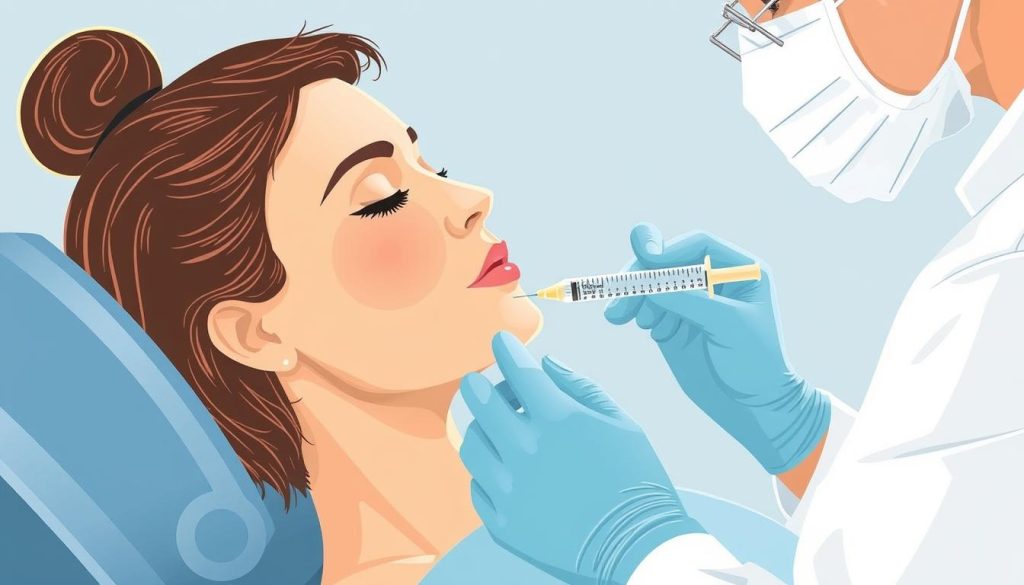
Mesotherapy Options
Mesotherapy is another non-surgical approach that involves a series of injections with fat-dissolving compounds. This minimally invasive procedure can be effective for reducing submental fullness.
Benefits and Limitations of Non-Surgical Approaches
Non-surgical double chin reduction methods offer several benefits, including minimal downtime and gradual, natural-looking results. However, these treatments may require multiple sessions and can have side effects such as swelling, bruising, and pain.
Expected Timeline for Results
The timeline for results varies depending on the treatment and individual. Generally, patients can expect to see results within several weeks to months after completing the recommended number of treatment sessions.
Surgical Procedures for Double Chin Reduction
Surgical interventions can effectively address double chin concerns. For individuals with significant submental fullness, surgery offers a more definitive solution compared to non-surgical methods.
Liposuction and Lipolysis
Liposuction is a surgical procedure that removes fat from beneath the skin, sculpting the chin and neck contour. It involves making a small incision under the chin, through which a tube is inserted to suction out the fat. Lipolysis, including laser-assisted and ultrasound-assisted methods, offers variations in technique.
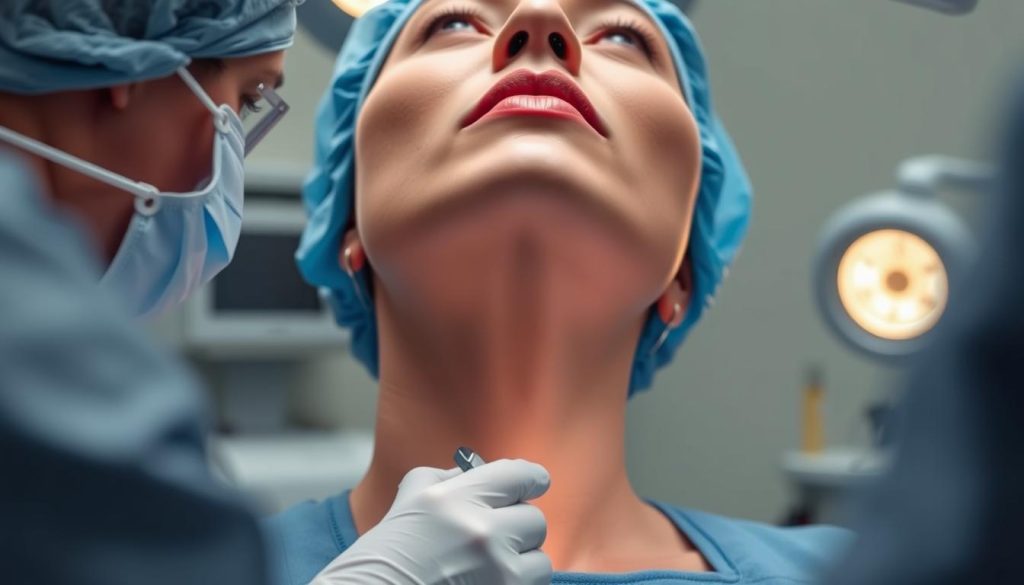
Face-Lift and Neck-Lift Procedures
A face-lift surgery allows doctors to remove fat and loose, saggy skin around the chin and neck, effectively reducing the appearance of a double chin. Neck-lift procedures, including cervicoplasty and platysmaplasty, aim to improve the contours of the neck and chin by removing excess skin or tightening neck muscles.
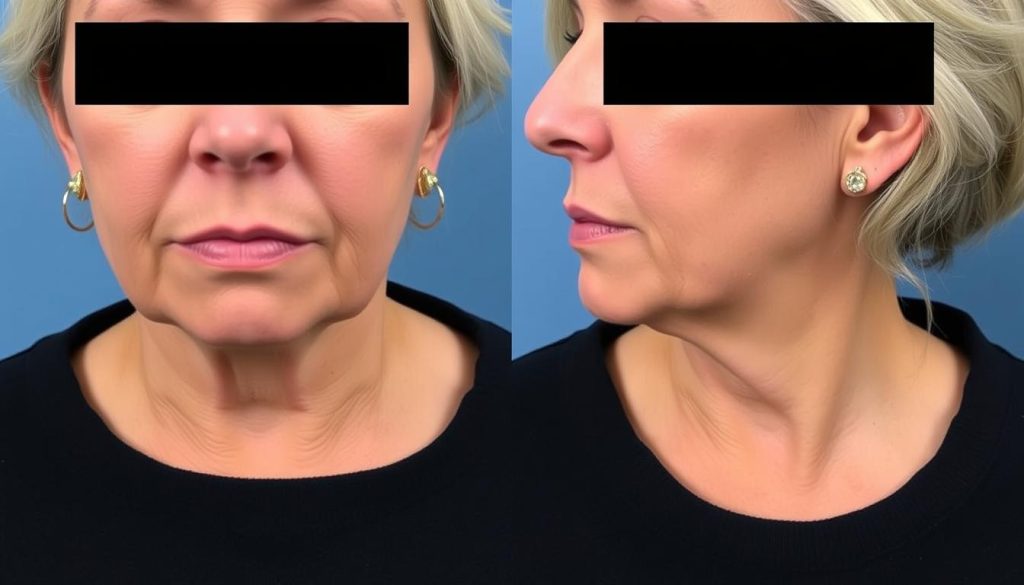
Cervicoplasty and Platysmaplasty
Cervicoplasty involves the removal of excess skin, while platysmaplasty tightens the neck muscles. These procedures complement each other and are often used in conjunction with face-lift surgery to achieve comprehensive rejuvenation.
Determining the Right Procedure for Your Needs
The choice of surgical procedure depends on individual factors such as age, skin elasticity, amount of excess fat, and desired results. A consultation with a plastic surgeon is essential to determine the most appropriate surgical approach.
By understanding the available surgical options and their implications, individuals can make informed decisions about their double chin reduction treatment.
Recovery and Results: What to Expect
Recovery and results are key concerns for individuals considering double chin reduction treatments. Understanding the recovery process is crucial for managing expectations and achieving optimal outcomes.
Typical Recovery Timeline
The recovery timeline varies depending on the procedure. Generally, patients experience bruising and swelling for about 10 to 14 days. Swelling can be managed with compression garments and cold compresses.
Managing Side Effects
Common side effects include swelling, bruising, and numbness. These can be managed through a combination of medical interventions and home remedies. For instance, pain management is typically achieved through prescribed medication.
| Procedure | Recovery Time | Common Side Effects |
|---|---|---|
| Surgical Liposuction | 2 weeks | Bruising, Swelling |
| Non-Surgical Treatments | Few days to a week | Mild Swelling, Redness |
Before and After Expectations
Results vary based on the treatment. Surgical procedures yield faster results, while non-surgical treatments take a few months to show significant improvement.
Maintaining Your Results
To maintain results, patients are advised to follow a healthy lifestyle, including a balanced diet and regular exercise. Proper skin care is also essential for maintaining the health and appearance of the skin in the treated area.
Making an Informed Decision About Double Chin Reduction
To rid yourself of a double chin, you must first understand the treatment options available. Consulting with qualified medical professionals, such as dermatologists or plastic surgeons, is crucial. They can help you weigh the benefits and risks associated with each treatment, including surgery and non-surgical procedures.
Consider factors like cost, downtime, and expected results when choosing a treatment. Evaluating before and after photos realistically and asking the right questions during consultations can also help. Additionally, consider your overall health and any medical conditions that may impact treatment eligibility.
FAQ
What is the most effective method for reducing submental fullness?
The most effective method depends on the individual’s condition and preferences. Deoxycholic acid injections, such as Kybella, and liposuction are popular options. It’s essential to consult a healthcare professional to determine the best approach.
How long does it take to see results from deoxycholic acid injections?
Results from deoxycholic acid injections are typically visible within 2-4 weeks after the treatment, with optimal results achieved after multiple sessions.
Are there any non-surgical alternatives to liposuction for submental fat removal?
Yes, Kybella injections and mesotherapy are non-surgical alternatives that can help reduce submental fat. These treatments involve injecting a solution into the fat beneath the submental area to break down fat cells.
What are the potential side effects of submental liposuction?
Common side effects of submental liposuction include swelling, bruising, and pain. These effects are usually temporary and resolve on their own within a few weeks.
Can facial exercises alone eliminate a double chin?
Facial exercises can help tone the muscles in the neck and face, but they may not be enough to eliminate a double chin entirely. A combination of exercises, lifestyle changes, and potentially other treatments may be necessary for optimal results.
How can I maintain my results after submental fat reduction?
Maintaining a healthy weight, following a balanced diet, and engaging in regular physical activity can help maintain the results of submental fat reduction. It’s also essential to follow post-treatment instructions provided by a healthcare professional.
